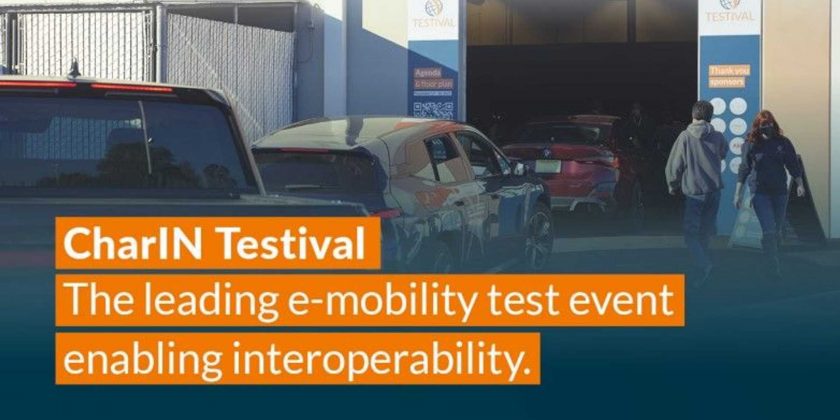Last month in Newark, California, the CharIN Association held its 5th North American Conference and Testival with 230 e-mobility experts from 85 businesses across 9 countries in attendance.
The non-profit CharIN Association is the leading global association that’s dedicated to promoting interoperability based on the Combined Charging System (CCS). CharIN has over 200 members, including 47 global automobile manufacturers, including companies that don’t even sell a car that uses CCS, like Toyota and Subaru.
The CharIN Association holds multiple Testival Conferences around the world every year, and for this year’s North American event, InsideEVs was granted a very rare opportunity to enter the testing facility and observe what goes on.
We weren’t allowed to take any pictures because there were EVs there that haven’t yet been released for sale and some that haven’t even been fully revealed yet, so the pictures we used for this article were provided to us by the event organizers and the copyright belongs to them.
Lucid Motor’s hosted the event in a facility they recently purchased and hadn’t yet begun outfitting it for their needs. Therefore, it was a perfect space for this event. One of this year’s main focuses was on Plug & Charge, which we’ll soon see included on every new EV offered.
About 230 international testers gathered to test interoperability between vehicles from a number of different manufacturers and a variety of CCS DC fast-charging stations. There were also five unique panel discussions covering critical topics facing the industry – from federal and state policy to grid resiliency, consumer adoption issues, and Plug & Charge.
I spoke with Cliff Fietzek, the former Senior Director of Technology for Electrify America and now CTO of InCharge Energy, about the Testival and why it’s so important for CharIN to host these events.
“Interoperability testing events like the CharIN Testing symposium are a key element in providing a seamless charging experience for EV buyers. And with InCharge Energy’s focus on commercial vehicles and fleets, it is extremely important to carry these best practices from the passenger vehicle space over to the commercial electric vehicle space. Interoperability between the charger and the EV is at least as important for last-mile delivery vans, electric school buses, and all the electric commercial and fleet vehicles which are entering the market.” Fietzek went on to say:
“The Plug and Charge technology which also got tested and validated with all the vehicles at the Testing symposium will come in commercial vehicles and is the basis for a standardized V2X capability based on ISO15118. Since also powering a customer’s home, building or feeding back into the power grid needs to be interoperable and standards-based.”
The reliability of public charging stations is vital for mass adoption of electric vehicles. It’s essential that every charging experience, regardless of which network or which EV is being charged, be easy to initiate and interruption-free. We’re not even close to that being the reality today, as charging sessions often require multiple attempts to initiate, and often the station shuts off prematurely without explaining why.
Plug & Charge technology has the potential to eliminate many of these issues, but currently, only the Porsche Taycan, Mustang Mach-E, and Lucid Air have it, and only the Electrify America network supports Plug & Charge across their entire network.
The charging stations were set up in lines, about 25-30 feet apart and the EVs took turns moving from one to the next station. Each time they would record data from the charging session and note any issues or charging anomalies. Representatives from the charging equipment manufacturers were there working with the OEMs and providing technical feedback from the charging session.
One thing that really impressed me was that I witnessed, on more than one occasion, engineers from one OEM comparing notes with engineers from a competing company. It truly appeared as though everyone just wanted to work together to improve interoperability and make sure all the vehicles work on all of the different charging equipment available.
Surprisingly, Tesla was there with a Model S, as were many OEMs that currently don’t sell a car in North America that uses the CCS standard. Tesla is in a unique position with the Supercharger network as they control everything – the cars, the charging equipment as well as the software that makes it all work seamlessly.
That’s not true for the rest of the industry. There are dozens of EV makers using equipment from dozens of suppliers running on software from a variety of different networks and that is causing a lot of compatibility issues, especially for EVs that are new to the market.
Rivian was also in attendance with not only an R1T, but also their own charging equipment that will be used for the upcoming Rivian charging network. They are looking to follow Tesla’s footsteps with a proprietary charging DC fast network, that they eventually open up to other brands.
Volvo had an electric truck and Proterra brought a bus to test out some of the higher-powered stations which were set up outside. Ford also had an electric Transit van for testing.
Overall it was inspiring to see so many EV charging experts all in one place, working together to help advance interoperability, which will greatly improve the charging experience for all EV drivers.
These Testival conferences bring everyone together under one roof to test all the different cars on all the different equipment so issues are found and corrected before they become the customer’s problem, and that’s definitely a good thing.
What issues with public charging would you like to see improved? Let us know in the comment section below.
Source: Read Full Article




